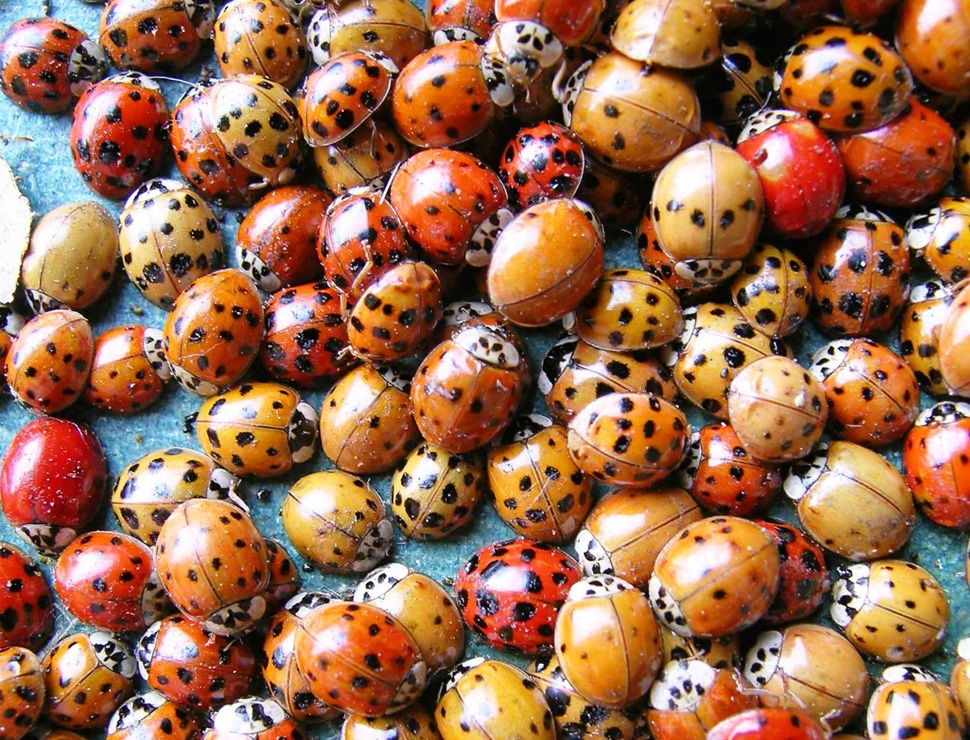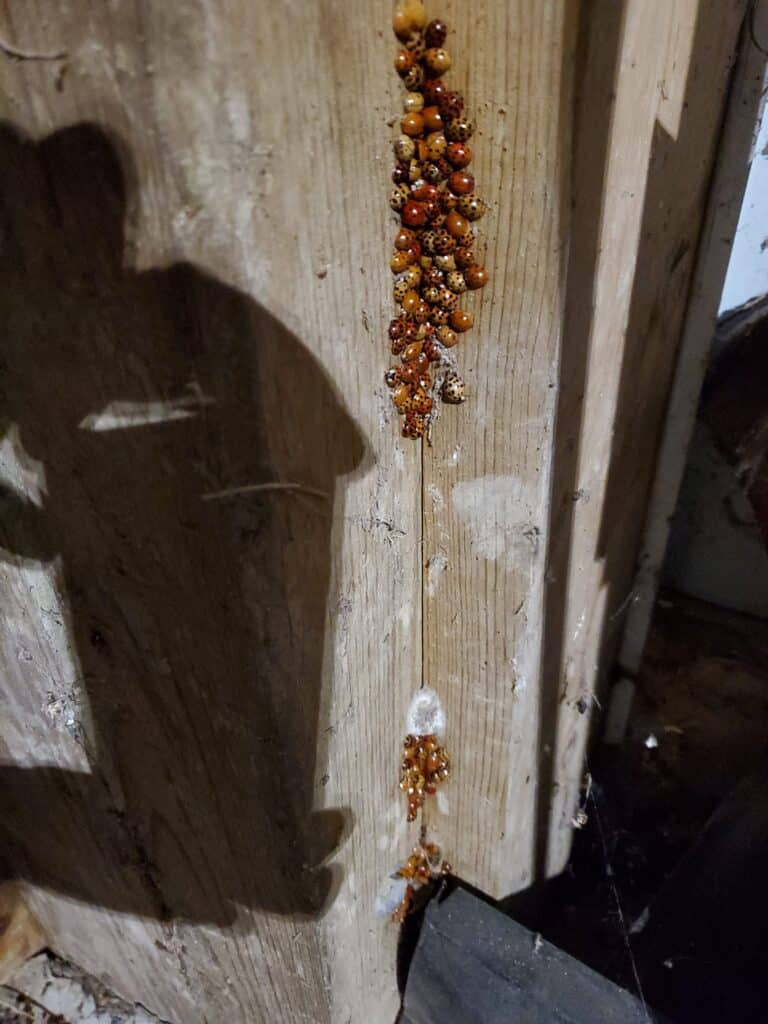Are you seeing an influx of Asian beetles in your home? Typically, these vibrant-colored insects are valuable for their role in controlling garden pests like aphids. That is true until they swarm your home, leaving you frustrated.
Although Asian beetles are harmless to humans, these small, colorful insects can invade your home in large numbers during the fall, seeking warmth. Fortunately, eliminating Asian beetles from your home is pretty simple.
With that said, let’s uncover the ways of getting rid of Asian beetles once and for all.
Why Are Asian Beetles In My Home?
Before we explore the different ways of eliminating Asian beetles, you likely want to know why they are in your home in the first place. Asian lady beetles, also called Harmonia axyridis, often enter homes for warmth when the cold months come.
They’re attracted to the sunlight and warmth that seeps through cracks and openings in windows, doors, or other entry points. Once inside, they may cluster in large numbers, particularly in wall voids, attics, or other secluded areas.
While Asian beetles won’t hurt you, they can be a nuisance due to their numbers and occasional odor when disturbed.
Read More:
- How To Get Rid Of Japanese Beetles
- How To Get Rid Of Centipedes In House
- How To Get Rid Of Stink Bugs Home Remedy
- How To Get Rid Of Pantry Moths Naturally
How To Get Rid Of Asian Beetles
In order to control the Asian beetle population in your home, prevention and also elimination measures are fundamental.
Prevention Measures
1. Seal Entry Points
Asian beetles are in your home due to the presence of entry points. To identify these areas, thoroughly inspect your home, ensuring you check the following areas:
- Exterior walls
- Foundation
- Siding
- Gaps around utility pipes or wires
- Window frames
- Doorways
- Vents, exhausts, and chimney openings
After identifying the entry points, fill gaps and cracks with caulk or sealant, then smooth the application with a putty knife or your finger. Also, to create a snug seal when you close your doors and windows, install weather stripping around the frames.
Cover all vents, exhausts, and chimney openings with fine mesh screens or netting to keep Asian Beetles out.
2. Outdoor Maintenance
Keeping your outdoor areas in excellent condition is key to deterring Asian beetles from congregating around your home and finding entry points. But how do you keep your outdoors unfriendly to Asian Beetles?
- Vegetation attracts Asian beetles and can help them get inside your house. Therefore, regularly prune trees, shrubs, and plants close to your home.
- Maintain a cleared zone of about 18-24 inches around the perimeter of your home to minimize direct contact between foliage and your house.
- Regularly rake and remove leaves, grass clippings, and other organic debris because these areas attract Asian beetles looking for shelter.
- Store firewood, mulch, and other clutter away from the house.
- Consider using yellow or sodium vapor light bulbs for outdoor lighting. These emit wavelengths that are less attractive to Asian beetles than standard white lights. If you already have white exterior lights, replace them with yellow or sodium vapor bulbs.
3. Use Natural Deterrents
There are various natural deterrents you can use in your garden or around potential entry points to discourage beetles from approaching. The best part is that you don’t have to resort to chemicals.
Some options worth considering are:
- Citrus Oil
Mix citrus essential oils (like lemon, orange, or lime) with water in a spray bottle. Spray around potential entry points like windows with the solution. The scent will repel Asian beetles.
- Cedar Oil
Cedarwood has natural insect-repelling properties, like its strong scent. Use cedar oil or cedar chips around entryways, windowsills, and other areas where beetles might enter.
- Neem Oil
Dilute neem oil derived from the neem tree with water and spray it on plants and surfaces to repel Asian beetles. Reapply after rain for continued effectiveness.
- Garlic Spray
Crush and soak garlic cloves in water overnight, then strain the liquid and dilute it further. Spray this garlic solution on affected areas or around entry points to deter beetles.
- Vinegar
Spray vinegar and water solution around windows, doors, and cracks.
- Essential Oils
Create a blend of essential oils like peppermint, eucalyptus, tea tree, or lavender, dilute them then spray the solution to deter Asian beetles.
4. Natural Predators
Encouraging natural predators on your property can play a significant role in controlling Asian beetle populations. However, do not rely on this approach solely to get rid of these insects. It works better with other methods.
Some predators that eat Asian beetles include:
a) Birds
Swallows: Species like barn swallows are known to feed on flying insects, including Asian beetles, reducing their numbers.
Sparrows and Starlings: These birds also consume a variety of insects and may help in controlling beetle populations.
b) Predatory Insects
Lacewings: Their larvae feed on soft-bodied insects, including Asian beetles, making them effective natural predators.
Ladybugs: Certain species of ladybugs are predatory and feed on aphids, which are a primary food source for Asian beetles.
c) Spiders
Orb-Weaver Spiders: These spiders build webs that can trap flying insects, including Asian beetles.
d) Predatory Mites
Mites: Some species of predatory mites consume small insects and their eggs, contributing to the control of pest populations, including Asian beetles.
Tips For Luring Asian Beetles’ Predators To Your Home
- Provide habitats such as birdhouses, bird feeders, and diverse plantings that attract insects that natural predators feed on.
- Minimize using broad-spectrum pesticides to protect beneficial insects and help maintain the natural predator-prey balance.
- Maintain a diverse ecosystem in your garden or outdoor spaces to support a variety of predator species.
5. Pest-Resistant Landscaping
Choose plants that Asian beetles find less appealing. These include basil, thyme, mint, rosemary, peony, iris, coneflower, astilbe, lilac, boxwood, dogwood, and holly. Native plants are worthy choices since they typically exhibit more resistance to local pests and diseases.
6. Educate And Monitor
Familiarize yourself with Asian beetles’ appearance, habits, and life cycle, including their shelter and food source preferences. Also, educate family members and household occupants about the presence of Asian beetles and their potential entry points. Teach them to recognize and report any sightings.
You should also set a schedule to inspect your home regularly, especially in the fall, before Asian beetles start seeking shelter.
Natural Remedies Against Asian Beetles
Prevention measures are essential to keeping your home free of Asian Beetles, but do not overlook the power of natural remedies. With these strategies, you won’t have to use chemicals.
a) Vacuuming
Are you looking for a direct, simple, yet effective method of eliminating Asian Beetles? Suck them with a vacuum. However, set your vacuum to a gentle suction setting to avoid crushing them and releasing the foul-smelling substance.
After vacuuming the Asian Beetles, clean and disinfect your vacuum cleaner to prevent beetles or their residue from remaining inside the machine. Incorporate vacuuming into your cleaning routine, especially during fall when Asian beetles seek shelter indoors.
b) Soap and Water Solution
Spray a solution of mild dish soap with water (1:1 ratio) directly on the Asian beetles to immobilize them and make it easier to remove them. However, use this solution sparingly to avoid leaving residue on surfaces and damaging some materials.
Once the solution immobilizes the Asian beetles, gently remove them with a tissue or vacuum.
c) Diatomaceous Earth
Sprinkle food-grade DE around your home’s perimeter, especially close to entry points. This powdery substance dehydrates bugs, including Asian beetles.
c) Herbal Sprays
Consider making an herbal spray using herbs like mint, basil, thyme, and rosemary that have repellent properties against beetles. To do so,
- Boil a pot of water and add a handful of chosen herbs, then let it simmer for around 20-30 minutes, allowing the herbs to release their repellent compounds into the water.
- After simmering, let the herbal mixture cool down, and then strain the liquid to remove any solid pieces of herbs.
Once you have your solution, transfer it into a spray bottle, then apply it on areas where Asian beetles are present or areas where they might enter, such as windows, doors, and cracks.
Note
Consider combining different herbs or adding essential oils with beetle-repelling properties to increase its potency.
Chemical Solutions
Use chemicals as a last resort or when natural and preventive methods have been insufficient in managing the infestation. The available options are:
1) Residual Insecticides
Apply residual insecticides for indoor use where you have observed Asian beetles. Focus on areas where beetles gather or enter, such as windows, crevices, doors, and cracks.
2) Exterior Insecticides
Use exterior insecticides specifically designed to form a barrier around your home’s perimeter. Apply these chemicals to the foundation, walls, and potential entry points outside your house.
Note
Wear protective gear when using chemicals because safety should be your priority. In addition, ensure that children and pets stay clear of treated spaces until they’re fully dry and safe for their interaction.
Apply insecticides selectively to areas where beetles are active or likely to enter, rather than blanket application.
Conclusion
In the battle against Asian beetles, employing a multifaceted approach is fundamental to complete eradication. So, seal entry points to fortify your home, apply natural defenses like DE and herbal spray, and vigilantly monitor your home. If necessary, use chemical interventions.

I’m Mike Hyle, an exterminator with 7+ years of experience handling all sorts of pests, including mice, cockroaches, bed bugs, and termites. I also write for Pest Solutions DIY blog to share my knowledge and help homeowners keep their homes pest-free. Outside work, I enjoy hunting, snowshoeing, and exploring nature. Check out my blog for helpful pest control tips!


